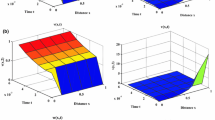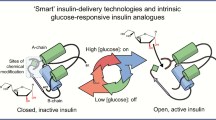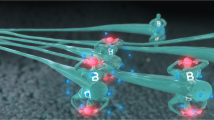Abstract
A mathematical model developed by Abdekhodaie and Wu (J Membr Sci 335:21–31, 2009), which describes a dynamic process involving an enzymatic reaction and diffusion of reactants and product inside glucose-sensitive composite membrane has been discussed. This theoretical model depicts a system of non-linear non-steady state reaction diffusion equations. These equations have been solved using new approach of homotopy perturbation method and analytical solutions pertaining to the concentrations of glucose, oxygen, and gluconic acid are derived. These analytical results are compared with the numerical results, and limiting case results for steady state conditions and a good agreement is observed. The influence of various kinetic parameters involved in the model has been presented graphically. Theoretical evaluation of the kinetic parameters like the maximal reaction velocity (V max) and Michaelis–Menten constants for glucose and oxygen (K g and K ox) is also reported. This predicted model is very much useful for designing the glucose-responsive composite membranes for closed-loop insulin delivery.











Similar content being viewed by others
Abbreviations
- C g :
-
Concentration of glucose (mol/cm3)
- C ox :
-
Concentration of oxygen (mol/cm3)
- C a :
-
Concentration of gluconic acid (mol/cm3)
- D g :
-
Diffusion coefficient of glucose (cm2/s)
- D ox :
-
Diffusion coefficient of oxygen (cm2/s)
- D a :
-
Diffusion coefficient of gluconic acid (cm2/s)
- K g :
-
Michaelis–Menten constant for glucose (mol/cm3)
- K ox :
-
Michaelis–Menten constant for oxygen (mol/cm3)
- V max :
-
Maximal reaction rate (mol/scm3)
- x :
-
Distance (mm)
- t :
-
Time (s)
- C *g :
-
Concentration of glucose in the external solution (mol/cm3)
- C *ox :
-
Concentration of glucose in the oxygen solution (mol/cm3)
- l :
-
Half thickness of the membrane (none)
- u :
-
Dimensionless concentration of glucose (none)
- v :
-
Dimensionless concentration of oxygen (none)
- w :
-
Dimensionless concentration of gluconic acid (none)
- X :
-
Dimensionless distance (none)
- τ :
-
Dimensionless time (none)
- γ E1, γ S1, γ E, α, β :
-
Dimensionless reaction diffusion parameters (none)
References
Abdekhodaie MJ, Wu XY (2005) Modeling of a cationic glucose sensitive membrane with consideration of oxygen limitation. J Membr Sci 245:119–12714
Abdekhodaie MJ, Wu XY (2009) Modeling of a glucose sensitive composite membrane for closed-loop insulin delivery. J Membr Sci 335:21–31
Albin G, Horbett TA, Ratner BD (1990) Glucose sensitive membranes for controlled deliver of insulin. In: Kost J (ed) Pulsed and self-regulated drug delivery. CRC Press, Boca Raton, pp 159–185
Bratlie KM, York RL, Invernale MA, Langer R, Anderson DG (2012) Materials for diabetes therapeutics. Adv Healthcare Mater. 1:267–284
Chu LY, Liang YJ, Wang HD, Yan L, Chen WM (2004) Research on the glucose-responsive gating membranes for controlled insulin delivery. Chin JMAP. 21(8):1–6
Ganesan S, Anitha S, Subbiah S, Rajendran L (2013) Mathematical modeling of a carrier-mediated transport process in a liquid membrane. J Membr Biol 245(11):435–442
He JH (1999) Homotopy perturbation technique. Comput Methods Appl Mech Eng 178(3–4):257–262
He JH (2014) Homotopy perturbation method with two expanding parameters. Indian J Physics. 88(2):193–196
Heller A (2005) Integrated medical feedback systems for drug delivery. AIChE J 51(4):1054–1066
Joy RA, Rajendran L (2012) Mathematical modeling and transient analytical solution of a glucose sensitive composite membrane for closed-loop insulin delivery using He’s Variation Iteration Method. Int Rev Chem Eng 4(5):516–523
Maori L, Ezekiel Dorcas, Bilal Joy (2012) Prevalence of Diabetes in Zambuk General Hospital. Report Opinion. 4(10):54–57
Michael KL, Chu JC, Gordijo CR, Chiang S, Ivovic A, Koulajian K, Giacca A, Wu XY, Sun Y (2012) In vitro and in vivo testing of glucose-responsive insulin-delivery micro devices in diabetic rats. Lab Chip 12:2533–2539
Rajendran L, Anitha S (2013) Reply to comments on analytical solution of amperometric enzymatic reactions based on Homotopy perturbation method. by Ji-Huan He. Lu-Feng Mo, Electrochimica Acta 102:474–476
Rajendran L, Bieniasz LK (2012) Analytical expressions for the steady-state concentrations of glucose, oxygen and gluconic acid in a composite membrane for closed-loop insulin delivery. J Membr Biol 246(2):121
Ravaine V, Ancla C, Catargi B (2008) Chemically controlled closed-loop insulin delivery. J Control Release 132:2–11
Sattanathan K, Gomathi S, Kavitha P, Zakkaria K, Sambathkumar R (2015) Impact of patient counseling on diabetes mellitus patients in the territory care hospital erode district. J Pharm 2(1):10–15
Yam F, Wu XY (1999) A novel composite membrane for temperature responsive permeation. Polymer Preprint. 40:312–313
Yam F, Wu XY, Zhang Q (2000) A novel composite membrane for temperature and pH- responsive permeation. Am Chem Soc 26:263–272
Zhang K, Wu XY (2002) Modulated insulin permeation across a glucose-sensitive polymeric composite membrane. J Control Release 80:169–178
Zhang K, Quan C, Huang H, Taulier N, Wu XY (2004) On the stability of insulin delivered through a new glucose-responsive polymeric composite membrane. J Pharm Pharmacol 56:611–620
Zhen G, Aimetti AA, Wang Q, Dang TT, Zhang Y, Veiseh O, Cheng H, Langer RS, Anderson DG (2013) Injectable nano-network for glucose-mediated insulin delivery. Chem Biol Eng 7(5):4194–4201
Author information
Authors and Affiliations
Corresponding author
Electronic supplementary material
Below is the link to the electronic supplementary material.
Appendix: Approximate analytical solution of Eqs. (8, 9) from the relation between the concentrations u, v, and w
Appendix: Approximate analytical solution of Eqs. (8, 9) from the relation between the concentrations u, v, and w
From the Eqs. (7, 8), we can obtain the following equation.
Then (26) becomes
Using the boundary conditions in Eqs. (11, 12), the boundary conditions for M will be
Now by applying Laplace transform in (28) and using complex inversion formula and proceeding as in Appendix A, the solution of (28) will be
From (27), we have
The analytical expression for the concentration v can be obtained by substituting (A9) and (32) in (33). Similarly, the relation between u and w from the Eqs. (7, 9) is obtained by
Let
Then (34) becomes
Using the boundary conditions in (10) to (12), the boundary conditions for N will be
Now by applying Laplace transform in (36, 37, 38 and 39) and using complex inversion formula (Appendix A, Online resource), the solution of (36) becomes as
From (35), we have
Using the above equation, we can obtain the Eq. (15) (the analytical expression for the concentration of w) in the text.
Rights and permissions
About this article
Cite this article
Mehala, N., Rajendran, L. & Meena, V. Part-2: Analytical Expressions of Concentrations of Glucose, Oxygen, and Gluconic Acid in a Composite Membrane for Closed-Loop Insulin Delivery for the Non-steady State Conditions. J Membrane Biol 250, 89–101 (2017). https://doi.org/10.1007/s00232-016-9939-5
Received:
Accepted:
Published:
Issue Date:
DOI: https://doi.org/10.1007/s00232-016-9939-5




